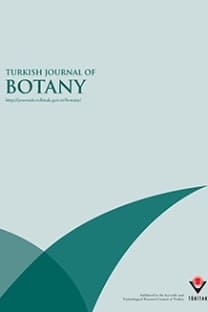Cellular patterns and metabolic changes during tepal development in Lilium tsingtauense
Cellular patterns and metabolic changes during tepal development in Lilium tsingtauense
___
- Bieleski R, Elgar J, Heyes J (2010). Mechanical aspects of rapid flower opening in Asiatic lily. Annals of Botany 86: 1175-1183.
- Boyer JS, Cavalieri AJ, Schulze ED (1985). Control of the rate of cell enlargement: excision, wall relaxation, and growth-induced water potentials. Planta 163: 527-543.
- Collier DE (1997). Changes in respiration, protein and carbohydrates of tulip tepals and Alstromeria petals during development. Journal of Plant Physiology 150: 446-451.
- Cosgrove DJ (2001). Wall structure and wall loosening. A look backwards and forwards. Plant Physiology 125:131-134.
- Evans RY, Reid MS (1988). Changes in carbohydrates and osmotic potential during rhythmic expansion of rose petals. Journal of the American Society for Horticultural Science 113: 884-888. Gookin TE, Hunter DA, Reid MS (2003). Temporal analysis of alpha and beta-expansin expression during floral opening and senescence. Plant Science 164: 769-781.
- Griesel WO (1954). Retardation of maturation in magnolia flowers by maleic hydrazide. Science 119: 843-845.
- Harada T, Torii Y, Morita S, Onodera R, Hara Y et al. (2011). Cloning, characterization, and expression of xyloglucan endotransglycosylase/hydrolase and expansin genes associated with tepal growth and development during carnation flower opening. Journal of Experimental Botany 62: 815-823.
- Ho LC, Nichols R (1977). Translocation of 14C-sucrose in relation to changes in carbohydrate content in rose corollas cut at different stages of development. Annals of Botany 41: 227-242.
- Ichimura K, Kawabata Y, Kishimoto M, Goto R, Yamada K (2003). Shortage of soluble carbohydrates is largely responsible for short vase life of cut ‘Sonia’ rose flowers. Journal of the Japanese Society for Horticultural Science 72: 292-298.
- Ichimura K, Kohata K, Koketsu M, Shimamura M, Ito A (1998). Identification of pinitol as a main sugar constituent and changes in its content during flower bud development in carnation (Dianthus caryophyllus L.). Journal of Plant Physiology 152: 363-367.
- Koch K (2004). Sucrose metabolism: regulatory mechanisms and pivotal roles in sugar sensing and plant development. Current Opinion in Plant Biology 7: 235-246.
- Lee YK, Rhee JY, Lee SH, Chung GC, Park SJ et al. (2018). Functionally redundant LNG3 and LNG4 genes regulate turgor-driven polar cell elongation through activation of XTH17 and XTH24. Plant Molecular Biology 97: 23-36.
- Li W, Zhang J, Sun H, Wang S, Chen K et al. (2018). FveRGA1, encoding a DELLA protein, negatively regulates runner production in Fragaria vesca. Planta 247: 941-951.
- Livak KJ, Schmittgen TD (2001). Analysis of relative gene expression data using real-time quantitative PCR and the 2–∆∆CT method. Methods 25: 402-408.
- Luo J, Ma N, Pei H, Chen J, Li J et al. (2013). A DELLA gene, RhGAI1, is a direct target of EIN3 and mediates ethylene-regulated rose petal cell expansion via repressing the expression of RhCesA2. Journal of Experimental Botany 64: 5075-5084.
- Norikoshi R, Imanishi H, Ichimura K (2013). Changes in cell number, osmotic potential and concentrations of carbohydrates and inorganic ions in Tweedia caerulea during flower opening. Journal of the Japanese Society for Horticultural Science 82: 51-56.
- Peng J, Carol P, Richards DE, King KE, Cowling RJ et al. (1997). The Arabidopsis GAI gene defines a signaling pathway that negatively regulates gibberellin responses. Genes & Development 11: 3194-3205.
- Ruhlmann JM, Kram BM, Carter CJ (2010). CELL WALL INVERTASE 4 is required for nectar production in Arabidopsis. Journal of Experimental Botany 61: 395-404.
- Sajjaanantakul T, Pitifer LA (1991). Pectin esterase. In: Walter RH (editor). The Chemistry and Technology of Pectins. San Diego, CA, USA: Academic Press, pp 135-164.
- Seymour GB, Gross KC (1996). Cell wall disassembly and fruit softening. Postharvest News and Information 7: 45N-52N. Suzuki H, Rodriguez-Uribe L, Xu J, Zhang J (2013). Transcriptome analysis of cytoplasmic male sterility and restoration in CMS-D8 cotton. Plant Cell Reports 32: 1531-1542.
- Szymanski DB, Cosgrove DJ (2009). Dynamic coordination of cytoskeletal and cell wall systems during plant cell morphogenesis. Current Biology 19: R800-R811.
- Yamada K, Norikoshi R, Suzuki K, Imanishi H, Ichimura K (2009). Determination of subcellular concentrations of soluble carbohydrates in rose tepals during opening by nonaqueous fractionation method combined with infiltrationcentrifugation method. Planta 230: 1115-1127.
- Yamada K, Takahashi R, Fujitani C, Mishima K, Yoshida M et al. (2009). Cell wall extensibility and effect of cell-wall-loosening proteins during rose flower opening. Journal of the Japanese Society for Horticultural Science 78: 242-251.
- Ye J, Coulouris G, Zaretskaya I, Cutcutache I, Rozen S et al. (2012). Primer-BLAST: a tool to design target-specific primers for polymerase chain reaction. BMC Bioinformatics 13: 134.
- ISSN: 1300-008X
- Yayın Aralığı: 6
- Yayıncı: TÜBİTAK
Sevcan ÇELENK, Gülnar İSMAILOVA, Bayram YILDIZ, Tuncay DİRMENCİ, Taner ÖZCAN, Turan ARABACI
Haniyeh NAFISI, Valiollah MOZAFFARIAN, Shahrokh KAZEMPOUR-OSALOO, Mohammad AMINI-RAD
Kazem NEGARESH, Mohammad Reza RAHIMINEJAD
Syntaxonomic analysis of forests, shrubs, and steppes of Tavşan Mountain (Amasya, Turkey)
Erkan YALÇIN, Hasan KORKMAZ, Cengiz YILDIRIM, Arzu CANSARAN
Tuncay DİRMENCİ, Taner ÖZCAN, Turan ARABACI, Sevcan ÇELENK, Gülnar İSMAYİLOVA, Bayram YILDIZ
Cellular patterns and metabolic changes during tepal development in Lilium tsingtauense
Li WEI, Jiang XINQIANG, Liu QINGHUA, Chi XIUFENG, Wang KUILING, Wang JIANPING, Liu QINGCHAO
Yousef AJANI, Regine CLASSEN-BOCKHOFF
Haniyeh NAFISI, Shahrokh KAZEMPOUR-OSALOO, Valiollah MOZAFFARIAN, Mohammad Amini RAD
Alejandro SANTIAGO, Oussama AHRAZEM, Lourdes GÓMEZ-GÓMEZ, Miguel ángel COPETE, Raquel HERRANZ, Pablo FERRANDIS
